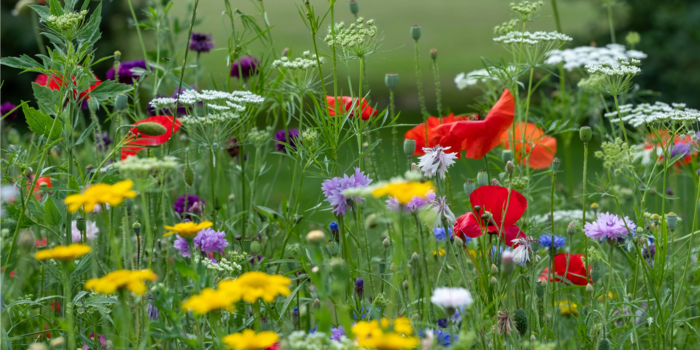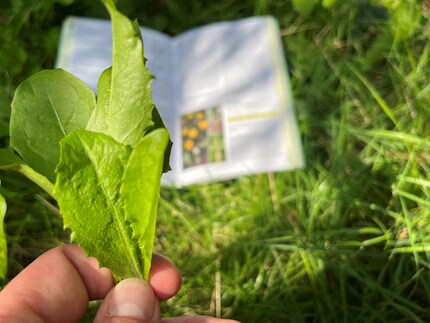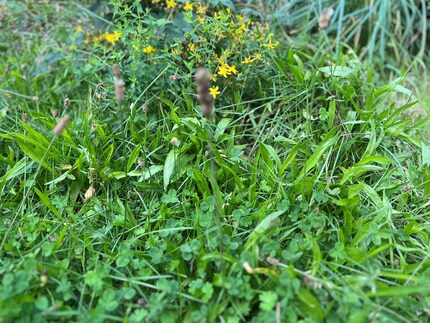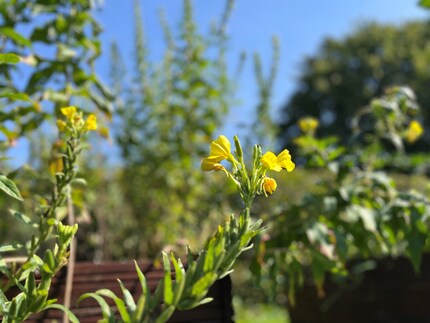
Essbare Wildpflanzen
German, Jürgen Guthmann, Steffen Guido butcher, Roland Spiegelberger, 2015

What we buy as expensive food is available for free in nature: which wild herbs can be used for what and how you can easily find them.
It's not just for beauty's sake that it's worth taking a walk through a wild meadow or forest from time to time. Culinary fans also get their money's worth: nature is full of delicious plants that many people think are inedible. Far from it, because many healthy and tasty herbs await you in the meadows.
Now, of course, you don't want to and shouldn't just forage your way through the colourful variety, as there may also be poisonous and inedible herbs. A plant guide is then a good guide. I went on a search in my garden with "Essbare Wildpflanzen" (Edible Wild Plants) from atVerlag and quickly found what I was looking for.

Essbare Wildpflanzen
German, Jürgen Guthmann, Steffen Guido butcher, Roland Spiegelberger, 2015
This compact, illustrated book provides background information on 200 edible wild plants, the botanical basics and information on plant parts, harvest time and use in the kitchen. Especially important: In addition, descriptions of poisonous plants with which there is a risk of confusion help to avoid accidental mistakes.
Dandelion, also known as meadow cowflower, is a classic in the wild herb kitchen. The young leaves are suitable as a salad ingredient; buds and stems can be processed into jelly, syrup or chutney. The same goes for the flowers, which are also a pretty, yellow decoration for salads and vegetables.
The herb guide lists the best time to harvest each plant and its usable parts. There are also tips on processing. In this case, for example, the advice to steep the dandelion leaves in salted water for an hour to make them milder. The guide also provides information about the flavour (here: chicory-like), the ingredients (here: bitter substances and flavonoids, among others) and possible medicinal effects (here: diuretic, among others).

The herb guide also offers a quick, compact overview of ribwort plantain, which is just as easy to find in many places as dandelion. The young, aromatic leaves should be cut across the longitudinal fibres. They are delicious as a salad, bread topping or processed into leafy vegetables like spinach. The flavour is described as mushroom-like. Further tips on using the flowers, seeds and roots will make you want to try it out for yourself. As one of the most widely used medicinal plants since ancient times, this inconspicuous plant has a wide range of healing properties: Among other things, it helps with swelling, skin inflammation and burns.

The metre-high, stately flowering plants have virtually conquered my garden in recent years. They produce a rich harvest all year round: Starting before the flowering period with the tasty roots grated as a salad garnish or in vegetable casseroles, followed by the steamed leaves, the flowers (buds) in summer salads or as oil, and finally the fruits and seeds in late summer and autumn. Evening primrose oil contains so-called gamma-linolenic acid. This essential, polyunsaturated fatty acid is rarely found in plants and is of great importance for humans. The oil can also be used against neurodermatitis and acne as well as for high blood pressure and to lower cholesterol levels.

So before you go to the greengrocer's next time, take a look at the nearest wildflower meadow, maybe you'll find what you're looking for there. The plant guide also provides a compact overview of the plants mentioned according to flower colour and number of leaves. This makes it easier to identify the respective plant. You can also consult an identification app if you are unsure.
If you would like to read more on the topic, you can find more wild herb tips here:
Science editor and biologist. I love animals and am fascinated by plants, their abilities and everything you can do with them. That's why my favourite place is always the outdoors - somewhere in nature, preferably in my wild garden.
Practical solutions for everyday problems with technology, household hacks and much more.
Show all